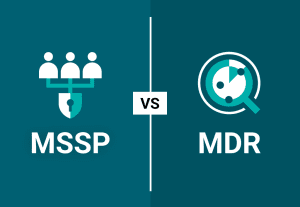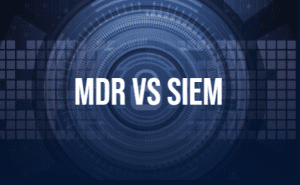Also known as Managed EDR, Managed XDR, and MXDR, Managed Detection and Response or MDR is a cybersecurity offering that requires a professional unit to track and monitor endpoints, networks, and cloud environments. A good MDR service provider alleviates the expense and effort required by a firm to derive value from an EDR solution. Moreover, it responds to alerts and render actionable recommendations too.
Table of Contents
ToggleWhat is MDR?
Have you seen an alarm company monitoring closed circuit TV for intruders? That’s how MDR works! Trained professionals work 24/7 to search for signs and signals of attackers breaching a computer network or cloud service. Upon incursion, they respond in a timely manner to evade the threat. MDR experts possess profound knowledge and experience of the threat landscape, the technology, and associated telemetry. They can investigate every alert and false positive to ensure high-level security.
Benefits of MDR
- Better security measures, proactive, and responsive approaches to threat hunting.
- Not all security threats are same: Various factors can control the priority of events. An MDR service provider organizes the list of threats and places the most stringent risk on top.
- MDR propels shorter mean time to response (MTTR) and mean time to detect (MTTD) against deliberate attacks.
- Provide round-the-clock coverage and information on threat hunting, forensic investigation, and incident response.
- MDR professionals offer controlled remediation and guided responses against targeted malware or other cyber threats.
Managed Detection and Response (MDR) – Solutions & Responses
At times, organizations encounter issues in implementing a cybersecurity program. Technological complexities, cloaking criminal activities, and immense data sharing can cause a multitude of threats transmuting in a computer system or server. MDR is a viable resource that firms can implement to ensure safety.
Human Resource Shortages
Due to lack of qualified experts, the cybersecurity industry faces enormous challenges in the hiring and recruitment process. Consequently, firms opt for outsourcing the entire security structure. Managed Detection and Response (MDR) services is an ideal choice in this regard.
Limited Access to Expertise
Together with issues of limited knowledge, firms also face trouble in filling specialized positions related to malware analysis, cloud security, and incident response. At this point, a firm call in the services of a specialized team of experts. In other words, Managed Detection and Response.
Advanced Threat Identification
Tough cybercriminals, such as advanced persistent threats (APTs), create tools and strategies to evade detection from cyber security responses. By using proactive threat hunting, Managed Detection and Response assists organizations in identifying and eliminating threats of varying kinds.
Slow Threat Detection
Because of slow threat detection, several cyber security programs adversely affect the organization’s boundaries by permitting intrusions go undetected. Subsequently, firms opt for Managed Detection and Response Systems to counter the threat.
Security Immaturity
The cost of developing a successful cyber security program is high because of skilled staff requirement, equipment, and regulations. By sharing associated costs across its client base, Managed Detection and Response protects an organization against malicious cyber threats.
Comparisons
Below are various comparisons between different Managed Detection and Response Tools available.
MSSPs and MDR

Managed Security Service Providers (MSSPs) focus on monitoring, security management, and alert systems. Majority of MSSP services are geared towards passive tasks, automated with customer interactions.
Managed Detection and Response (MDR) encompasses proactive (i.e., real-time, human expert-led proactive threat hunting) and reactive (i.e., ongoing monitoring) actions. MDR offers alert response, investigation, and remediation in addition to indicators of compromise (IoC) triage.
MDR and Managed SIEM

Security Information and Event Management (SIEM) commences by collecting information from various network sources and security devices, thereafter analyzing anomalies that may signal malicious activity. SIEM capabilities vary widely. Some are managed event processing while others are technology-only solutions. Compared to MDR, SIEM is a high-end and resource-intensive service. MDR, on the other hand, offer light network footprint and time-value.
How to Select Managed Detection & Response Provider
Two main factors determine the effectiveness of Managed Detection and Response Services.
Years of Expertise
A good MDR service provider can manage threats of different types. Moreover, it entails attributes, such as Security and Operations Centre (SOC), Incident Response Teams, and Enterprise-level Platform Security Knowledge, including Cloud Computing and Endpoint Devices. These teams perform well if equipped with the essential resources. Comprehensive network visibility, secure data analytics, and the capacity to react quickly to possible security incidents are pivotal requirements for MDR providers.
Reviews & Testimonials
Having online reviews and testimonials written by clients is a plus point for cybersecurity firms. Prospects can be converted to customers in a short span of time. Moreover, it improves credibility and trust ratings.
Frequently Asked Questions
Q.1. What is the difference between MDR and SOC?
Ans. SOC is an element of MDR solution. It comprises skilled and trained cybersecurity personnel who monitor security of networks, computer systems, and cloud environments. MDR is a 24/7 solution handled by experts. It eliminates and remediate security threats by merging technology and security processes.
Q.2. What is Cybersecurity Framework?
Ans. The cybersecurity framework offers three components: Profiles, Implementation Tiers, and Core. It is a set of documents that describe standards, guidelines, and optimal practices planned for cybersecurity management.
Q.3. What are the Seven Layers of Cybersecurity?
Ans. The seven layers of cybersecurity include:
- Human Layer
- Perimeter Security Layer
- Network Layer
- Application Security Layer
- Endpoint Security Layer
- Data Security Layer
- Mission-Critical Assets


